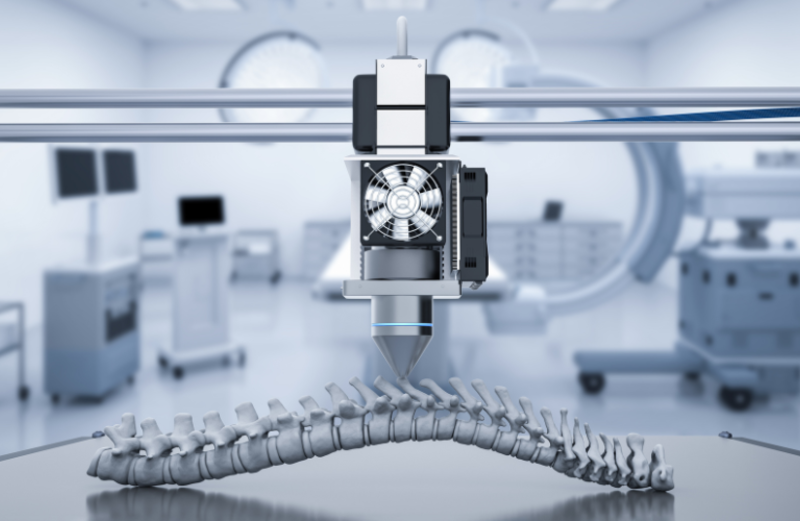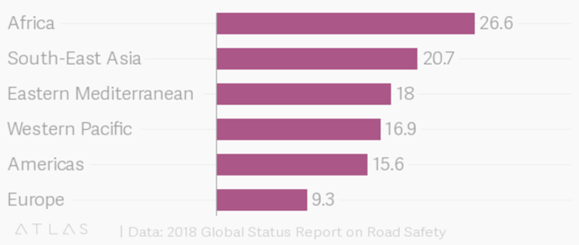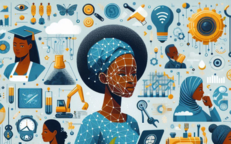Utilising 3D Printing Technology To Strengthen Orthopaedic Care In Africa

This is the 7th post in a blog series to be published in 2023 by the APET Secretariat on behalf of the AU High-Level Panel on Emerging Technologies (APET) and the Calestous Juma Executive Dialogues (CJED)
Healthcare systems in Africa are confronted with challenges which include traumatic injuries that are predominantly attributed to musculoskeletal diseases, also referred to as orthopaedic trauma. This condition is becoming more common in low-income and middle-income countries, including African countries. This condition is acknowledged globally as a primary cause of death, disability, chronic pain, and escalating healthcare expenses.[1] Traumatic injuries can result from various incidents, including road accidents, falls, workplace accidents, and violence.
In recent years, traumatic injuries in Africa have risen significantly, with road accidents being a major contributor primarily because Africa has the highest mortality rates resulting from road accidents compared to any other region (see figure 1)[2]. The poor state of road infrastructure and the lack of strict traffic laws and enforcement in many African countries has resulted in an increase in road accidents. [3] These accidents often lead to severe injuries, including fractures, spinal cord injuries, and traumatic brain injuries. Unfortunately, many of these injuries are preventable, but due to various factors such as lack of education, poverty, and inadequate health infrastructure, the injuries persist.

Figure 1: Number of road traffic deaths per 100 000 (2018)
Musculoskeletal diseases, such as arthritis, osteoporosis, and fractures are also on the rise in African countries, where the lack of adequate medical care often results in delayed treatment, leading to more severe outcomes, chronic pain, and disability. Moreover, the lack of access to advanced medical equipment, such as X-ray machines and MRI scanners, presents a significant challenge in diagnosing and treating these diseases effectively.[4]
The economic impact of orthopaedic trauma and musculoskeletal diseases in Africa is substantial. For example, the costs associated with treating these conditions are often high, and the lack of insurance coverage and social protection schemes exacerbates the financial burden on individuals and families. Additionally, the long-term consequences of these injuries, such as disability and chronic pain, can limit individuals' ability to work and contribute to their communities, leading to a loss of productivity and income.
Muscle, bone, joint and nearby connective tissue dysfunction results in temporary and sometimes, permanent limitations, and reduces function and mobility. These are attributable to approximately 150 different diseases and conditions in the form of musculoskeletal impairments. Musculoskeletal conditions are frequently defined by pain which is frequently persistent as well as restrictions in mobility and dexterity.[5] Such cases make it harder for people to work and engage in social activities and may sometimes result in disabilities. The main cause of musculoskeletal diseases on the continent is road accidents.
The primary inadequacy of Africa’s trauma healthcare system includes pre-hospital delays in bone fracture repair, challenges in fixing broken bones and tissues using metal screws, pins, rods, or plates to hold the bone in position, and delays in treatment. This is principally caused by delays in the deployment of medical equipment to treat trauma injuries.[6] Early treatment of orthopaedic trauma can significantly reduce recovery time and further save the patient from temporary or permanent disability by avoiding further injury.
To enhance orthopaedic trauma care in Africa, the African Union High-Level Panel on Emerging Technologies (APET) is calling upon African countries’ health sector to adopt 3D printing technology in treating orthopaedic trauma cases. 3D printing, sometimes referred to as additive manufacturing, is a process of making customised three-dimensional solid objects from a digital file.[7] Additive processes are used to create 3D-printed objects, where layers of material are added until the object is fully formed. These layers can be viewed as cross-sections of the object, produced sequentially.
3D printing technology is frequently employed in the medical field to produce customised medical tools such as haemostats, tweezers, clamps, Tibial Plateau elevators, AK Fracture Reducer, Bacastow, and retractors, which are commonly used in treating orthopaedic trauma injuries.[8] One of the significant benefits of 3D printing is the ease with which precise design modifications can be made based on surgeon feedback. These enhance the surgeon's understanding of the patient's anatomical features, including normal and traumatised bones and soft tissues, making preoperative planning more precise. The use of 3D printing technology is particularly useful for addressing supply chain issues and fulfilling the increasing demand for quickly produced medical tools.[9]
APET recognises that the use of 3D printing technology can provide millions of African people with access to corrective surgery and treatment for accident-related medical conditions, thereby changing their lives for the better. However, APET emphasises that for 3D printing to be successful in Africa, there should be a variation of infrastructure and manpower across units. The installation of industrial-grade machines, dedicated software, and the employment of trained personnel can enhance the capacity and reliability of 3D fracture treatment. The establishment of interdisciplinary 3D printing departments, with sound financial and management structures, can improve sustainability.
APET encourages African countries' health sector to deploy 3D printing technology in treating orthopaedic trauma cases as an innovative step towards improving healthcare delivery. This technology can provide faster and more affordable access to customised prosthetic limbs, implants, and orthotics. Additionally, the adoption of 3D technology can yield surgical guides that enhance precision, minimise complications, and reduce recovery time.
It is recommended that African governments should collaborate with private sector stakeholders to invest in 3D printing technology and establish specialised centres to train medical personnel and promote research and development. It is equally imperative that regulatory bodies develop quality assurance and certification standards to ensure the safety and efficacy of the products produced. Deploying 3D printing technology in the health sector can significantly contribute to achieving universal healthcare coverage while also addressing the shortage of healthcare professionals, particularly in rural areas. Furthermore, APET recommends that policymakers in Africa should prioritise the prevention and treatment of orthopaedic trauma injuries to mitigate the possibility of the working-class population experiencing long-term effects that could impede economic progress and hinder development efforts.
Finally, APET recommends that African countries align their 3D printing technology efforts and advances in healthcare with the aspirations of the African Union's Agenda 2063, Science, Technology, and Innovation Strategy for Africa (STISA)-2024, and United Nations' Sustainable Development Goals (SDGs).[10] This could involve establishing specialised centres for training medical personnel and promoting research and development, investing in 3D printing technology, developing quality assurance and certification standards, and creation of interdisciplinary 3D printing departments and businesses with sound financial and management structures. The deployment of 3D printing technology can address supply chain issues, improve surgical precision, reduce the risk of complications, shorten recovery time, and increase access to customised prosthetic limbs, implants, and orthotics. Prioritising the prevention and treatment of orthopaedic trauma injuries can result in a healthy workforce, thereby, positively impacting the economy and contributing to Africa's socio-economic development and growth.
Featured Bloggers – APET Secretariat
Aggrey Ambali
Justina Dugbazah
Barbara Glover
Bhekani Mbuli
Chifundo Kungade
Nhlawulo Shikwambane
[1]https://www.researchgate.net/publication/258445649_Orthopedic_Surgery_in_the_Developing_World_Workforce_and_Operative_Volums_in_Ghana_Compared_to_Those_in_the_United_States.
[2] https://www.weforum.org/agenda/2019/02/death-rates-from-traffic-accidents-are-higher-in-africa-than-anywhere-else/
[3]https://www.ncbi.nlm.nih.gov/pmc/articles/PMC9314752/#:~:text=Road%20traffic%20accidents%20were%20the,fractures%2C%20especially%20in%20developing%20countries.&text=Road%20traffic%20accidents%20are%20one,than%20in%20all%20other%20countries.
[4] Bohr, A., & Memarzadeh, K. (2020). The rise of artificial intelligence in healthcare applications. Artificial Intelligence in Healthcare, 25–60. https://doi.org/10.1016/B978-0-12-818438-7.00002-2.
[5] https://www.who.int/news-room/fact-sheets/detail/musculoskeletal-conditions.
[6] Bigham-Sadegh, A., & Oryan, A. (2015). Basic concepts regarding fracture healing and the current options and future directions in managing bone fractures. International wound journal, 12(3), 238–247. https://doi.org/10.1111/iwj.12231.
[7] https://3dprinting.com/what-is-3d-printing/.
[8] Lal, H., & Patralekh, M. K. (2018). 3D printing and its applications in orthopaedic trauma: A technological marvel. Journal of clinical orthopaedics and trauma, 9(3), 260–268. https://doi.org/10.1016/j.jcot.2018.07.022.
[9] https://www.aha.org/aha-center-health-innovation-market-scan/2022-06-07-3-ways-3d-printing-revolutionizing-health-care#:~:text=Fabrication%20of%20customized%20medical%20devices,rapidly%20based%20on%20surgeon%20feedback.
[10] https://www.iavi.org/phocadownload/Health%20Research%20and%20Innovation%20Strategy%20for%20Africa%202019.pdf.


